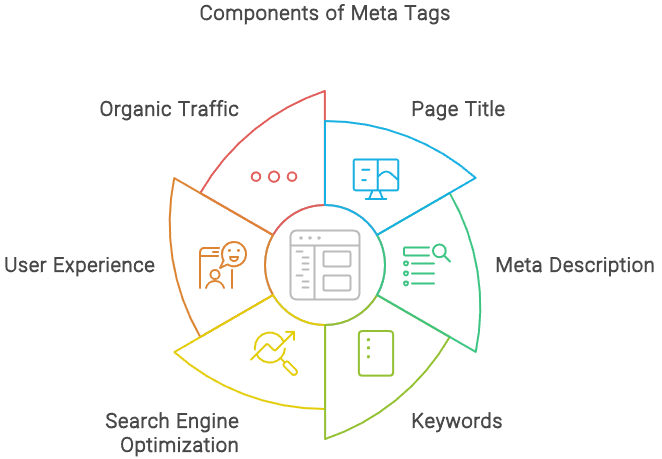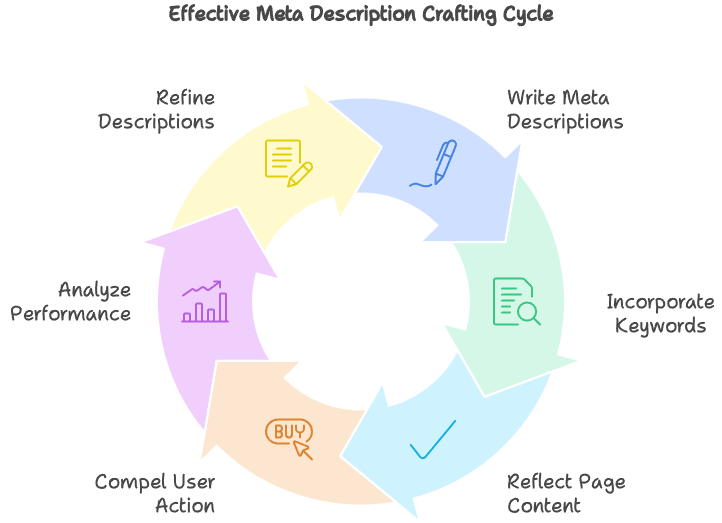The Importance of Meta Tags
Meta tags play a critical role in optimizing webpages for search engines and users alike. They help define the content of a page, making it easier for search engines to categorize and rank the site effectively. Understanding the importance of relevance, keywords, length, and uniqueness in meta tags can significantly enhance visibility and click-through rates.

Relevance and Keywords
Relevance is paramount when crafting meta tags. Including targeted keywords that align with the page content ensures that search engines recognize the topic and context. This alignment helps improve search rankings and makes the content more appealing to users. Tools for small businesses in 2024 should focus on identifying the most relevant keywords that resonate with their audience.
A well-structured meta tag should reflect the primary subject matter of the page. Using tools like keyword planners can assist in discovering high-ranking terms that can be seamlessly integrated into the meta tags.
| Meta Tag Element | Importance |
|---|---|
| Keywords | Essential for relevance and ranking |
| Relevance | Ensures alignment with user search intent |
Length and Uniqueness
The length of meta descriptions has evolved over the years. Google expanded the standard length for meta descriptions from 160 characters to up to 275 characters as of 2017 (WordStream). This change allows for more detailed descriptions that can better inform users about what to expect when they click through.

Uniqueness is equally important. Each page should have a distinct meta description to avoid duplication, which can confuse search engines and diminish the effectiveness of the meta tags. A compelling and unique meta description not only aids in SEO but also improves the user experience, increasing the chances of higher click-through rates.
| Meta Description Guidelines | Recommendations |
|---|---|
| Length | Up to 275 characters |
| Uniqueness | Avoid duplicates across pages |
Meta descriptions serve as a snapshot of the content, providing potential visitors with a clear idea of what they will find on the page. For more insights on optimizing meta tags and descriptions, consider reviewing our on-page SEO checklist and on-page SEO techniques.
Crafting Effective Meta Descriptions

Creating effective meta descriptions is essential for enhancing the visibility and appeal of a webpage in search results. Meta descriptions serve as a brief summary of the page content and can significantly influence user engagement.
Impact on Click-Through Rate
A compelling meta description can increase the click-through rate (CTR) of organic search results, resulting in more traffic to a site, even if the ranking remains unchanged (WordStream). Although meta descriptions do not directly affect search engine rankings, they can indirectly influence rankings by impacting CTR, which Google considers a factor for site quality and potentially affects ranking (Moz).
The following table highlights the potential impact of various factors on CTR:
| Factor | Impact on CTR |
|---|---|
| Compelling Meta Descriptions | High |
| Lengthy Descriptions | Medium |
| Vague Descriptions | Low |
Research indicates that Google rewrites meta descriptions for approximately 71% of first-page search engine results page (SERP) entries on mobile and 68% on desktop. This means that there is a significant chance that the meta descriptions crafted by site owners may be replaced by Google with its own version. Therefore, it is crucial to write custom meta descriptions for important pages to ensure they accurately reflect the content and encourage clicks.
Clarity and Call to Action
Effective meta descriptions should be clear, concise, and actionable. They must accurately represent the page’s content while enticing users to click. Including a strong call to action (CTA) can motivate users to engage with the content. Phrases like “Learn more,” “Discover,” or “Get started” can persuade potential visitors to take action.
A well-structured meta description should also focus on relevance and user intent. Google updated its guidelines in August 2022, emphasizing that meta descriptions should be compelling and informative, showcasing why users should click on a site (Stan Ventures). Here is a simple structure to follow when crafting meta descriptions:
| Component | Description |
|---|---|
| Summary of Content | Briefly describe what the page is about. |
| Unique Value Proposition | Highlight what makes the page special. |
| Clear Call to Action | Encourage users to click with actionable language. |
By ensuring clarity and incorporating a strong call to action, site owners can create effective meta descriptions that attract clicks and potentially improve their site’s performance. For more insights on optimizing on-page elements, refer to our on-page SEO checklist and explore further on-page SEO techniques.
Best Practices for On-Page SEO
Effective on-page SEO is crucial for enhancing a website’s visibility and performance in search engine results. Among the most important aspects of on-page SEO are meta tags and meta descriptions. Understanding their roles and adhering to Google’s guidelines can significantly impact a website’s SEO strategy.
Role of Meta Data
Meta tags are vital components of a webpage’s HTML and serve to describe the page’s content to both search engines and users. They appear in the section of an HTML document and provide essential information that helps search engines index the page accurately. While the significance of meta data for SEO rankings has evolved, it still plays a crucial role in influencing click-through rates and user engagement.
The key types of meta tags include:
| Meta Tag | Description |
|---|---|
| Title Tag | A ranking factor that describes the content of a page and appears as the clickable headline in search results. |
| Meta Description | A brief summary of the page content that appears in search engine results pages (SERPs). |
| Robots Tag | Controls indexing and tells search engines what to do with the page (index, follow, etc.). |
Optimizing these elements can enhance a webpage’s performance, leading to better rankings and increased traffic (SEO-Küche).
Google’s Guidelines and Updates
Google frequently updates its algorithms and guidelines, and staying informed about these changes is essential for effective SEO practices. Adhering to Google’s recommendations ensures that meta tags and descriptions are optimized and relevant. For example, although meta descriptions are not as critical for rankings as they once were, they still impact user behavior and click-through rates.
To optimize meta data effectively, consider the following best practices:
- Keep Title Tags Concise: Aim for 50-60 characters to ensure they display fully in search results.
- Craft Compelling Meta Descriptions: A length of 150-160 characters is ideal for providing a clear, engaging summary that encourages clicks.
- Use Relevant Keywords: Incorporate keywords naturally to enhance visibility without overstuffing.
- Ensure Uniqueness: Each page should have a distinct title and meta description to avoid duplication issues.
By following these guidelines and utilizing effective on-page SEO techniques, businesses can improve their search engine performance and attract more visitors to their sites. For additional insights, consider exploring our on-page SEO checklist and internal linking strategies.
Optimizing Title Tags and Meta Descriptions
Effective optimization of title tags and meta descriptions is essential for enhancing visibility and engagement on search engine results pages (SERPs). Following best practices can significantly impact a website’s performance in search engine rankings and user click-through rates.
Title Tag Optimization
When optimizing title tags, it’s critical to ensure that they are relevant, include keywords, and maintain uniqueness. Each title tag should accurately reflect the content of the page while incorporating primary keywords that users are likely to search for. This helps search engines understand the context of the page and improves the chances of ranking higher.
Here are some best practices for title tag optimization:
| Best Practice | Description |
|---|---|
| Relevance | Ensure the title accurately reflects the content of the page. |
| Keywords | Include primary keywords near the beginning. |
| Length | Keep the title between 50-60 characters to avoid truncation. |
| Uniqueness | Each page should have a distinct title to avoid duplication. |
By adhering to these practices, businesses can improve their chances of attracting organic traffic. For further insights, check out our on-page SEO checklist.
Meta Description Length and Content Strategy
Meta descriptions serve as a brief summary of a webpage’s content and are displayed on SERPs beneath the title. A compelling meta description can entice users to click through to a site, significantly increasing the click-through rate (CTR), even if the page’s ranking remains unchanged.
Google has expanded the standard length for meta descriptions from 160 characters to up to 275 characters as of 2017. This change allows for more detailed descriptions that can effectively convey the value of the webpage.
Key elements to consider for crafting effective meta descriptions include:
| Element | Description |
|---|---|
| Clarity | Ensure the message is clear and concise, accurately describing the page content. |
| Call to Action (CTA) | Include a persuasive CTA to encourage users to click, such as “Learn more” or “Get started.” |
| Avoid Duplicates | Each page should have a unique meta description to differentiate it from others. |
A well-crafted meta description not only improves the user experience but also enhances the overall effectiveness of on-page SEO techniques. For more information on optimizing your content, consider exploring internal linking strategies and image optimization for SEO.

